Species and Location
Arroyo Trabuco Creek (Trabuco Creek) is a 22-mile-long tributary of San Juan Creek in Orange County, CA. Trabuco Creek flows west and southwest before draining into San Juan Creek 2.25 miles upstream of the ocean. The lower section of Trabuco Creek flows through three cities and is affected by urban and agricultural runoff. Historically, Trabuco and San Juan Creeks both maintained populations of Southern California steelhead (Oncorhynchus mykiss) which are federally endangered and a candidate species for listing on the California endangered species act. In addition to O. mykiss, Arroyo Chub (Gila orcutti) also reside throughout Trabuco Creek, and partially Armored Threespine Stickleback (Gasterosteus aculeatus) are confirmed to reside downstream of Cleveland National Forest.
The upper miles of Trabuco Creek, within Cleveland National Forest, were stocked with O. mykiss until the Holy Fire in August 2018 which burned upper Trabuco Creek and Holy Jim Creek, a tributary to Trabuco Creek. Holy Jim Creek consists of 2.8 stream miles and flows south before connecting with Trabuco Creek in the upper portion of Trabuco Canyon. Holy Jim was stocked in the 1940s with O. mykiss, and in 1951 a creel census indicated that the O. mykiss population in Holy Jim consisted both of natural and stocked O. mykiss (CEMAR 2008).
Around 81 check dams were built in Trabuco and Holy Jim Creek starting as early as the 1930s to create deep pools to allow the survival of stocked trout for recreational fishing. In 2013, the US Forest Service began removing these dams as part of a larger effort to improve fish passage throughout Cleveland National Forest. Two total barriers to the upstream passage of steelhead rainbow trout remain at the Metrolink bridge and the I-5 freeway approximately 5 miles upstream of the ocean. Plans are being designed to retrofit these barriers in the upcoming years to provide fish passage to the upper portions of Trabuco Creek.
Resident O. mykiss in Trabuco Creek are concentrated in a short perennial section of creek within the Cleveland National Forest. These O. mykiss have the potential to intermix with anadromous steelhead and/or return to anadromy if all barriers to the ocean are removed. Holy Jim Creek has been devoid of fish in recent years, and in March 2022, the Jim Fire consumed approximately 500 acres of vegetation along Holy Jim Canyon and burned for 28 days.
Need for Drought Stressor Monitoring
Frequent monitoring is required to ensure O. mykiss in upper Trabuco Creek persists through drought conditions. CDFW staff wants to ensure the survival of this population of O. mykiss and Arroyo Chub so that they can continue to repopulate areas of the stream that were once blocked by check dams and barriers. When all the barriers are eventually removed, it will be pertinent to have a population of naturalized fish to spread out. Currently, the O. mykiss genetics are hatchery dominated, but genetically native southern California O. mykiss can be reintroduced into the system. Although Holy Jim is currently fishless, it once had favorable conditions for O. mykiss and can become populated once the stream recovers from fire impacts.
The fish populations in Trabuco Creek face many dangers including the long-term effects of the Holy (2018) and Jim (2022) Fires including sedimentation after heavy rains, causing pools in perennial habitats to fill with sediment. Sedimentation also reduces the amount of viable spawning habitat for O. mykiss, which require a more gravel-dominant substrate to successfully spawn. Fires also reduce the amount of vegetation present along streambanks, which can increase stream temperatures and reduce available cover for fish to hide from predation.
Lack of rainfall in drought years also reduces the amount of available habitat for fish. Lower water levels can eventually strand fish in shallow, inhospitable bodies of water with low dissolved oxygen levels. CDFW staff rescues fish in peril, relocating them to deeper, perennially oxygenated pools where they can survive over summer.
Stressor Monitoring Efforts
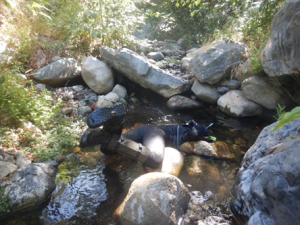 Figure 1. Photo of a CDFW snorkeler searching for O. mykiss and Arroyo Chub in upper Trabuco Creek.
Figure 1. Photo of a CDFW snorkeler searching for O. mykiss and Arroyo Chub in upper Trabuco Creek.
Five monitoring sites, one in middle Trabuco Creek and four in the upper watershed, are visited every 4-6 weeks. Flow, water quality, and pool metrics are recorded. During the hot summer months, walking surveys are conducted to determine how connected the stream is. GPS locations are collected at each point the stream goes wet or dry to assess the extent of drought effects. These surveys also help to identify fish that might need rescuing. Rescue efforts in 2021 led to the relocation of 1,748 Arroyo Chub above a barrier. In July of 2022, a snorkel survey was conducted along 1.68 miles in Upper Trabuco to assess the current O. mykiss and Arroyo Chub populations (Figure 1). A walking survey was completed in Holy Jim in August 2022 to assess the damage from the Jim Fire and collect wetted extent data to compare to 2021 data.
Findings
Throughout 2022, all parameters (pH, turbidity, conductivity, salinity, dissolved oxygen and temperature) remained consistent as discharge decreased. Water temperature ranged between 10.76°C to 19.8°C. Flow decreased in Cleveland National Forest from 1.39 cfs in early February 2022 to 0.15 cfs as of September 2022.
In July 2022, a snorkel survey was conducted along 1.68 miles of upper Trabuco Creek within Cleveland National Forest to assess the relative abundance of Arroyo Chub and O. mykiss. In 2021, a population of 1,748 Arroyo Chub were moved from a downstream drying area below a barrier in Upper Trabuco Creek farther upstream above the barrier. The chub had migrated distances up to 0.28 miles from the original relocation pool in 2021 and were present in 12 different units within the snorkeled area. Three hundred and twenty O. mykiss were counted during this survey, 10.6% of which were young of the year. (Figures 2 & 3).
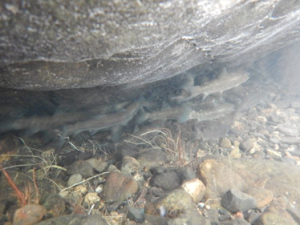 Figure 2. About 46 O. mykiss were found in this large pool (max depth 1.82ft) during a snorkel survey, July 2022.
Figure 2. About 46 O. mykiss were found in this large pool (max depth 1.82ft) during a snorkel survey, July 2022.
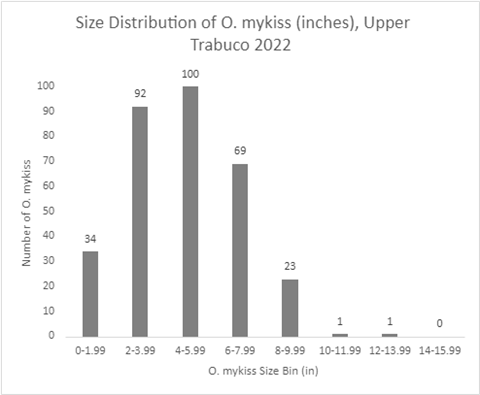 Figure 3. A graph displaying size distribution of O. mykiss in two-inch size bins, July 2022.
Figure 3. A graph displaying size distribution of O. mykiss in two-inch size bins, July 2022.
Due to the removal of a total barrier by the US Forest Service in upper Trabuco Creek in March 2022, O. mykiss have been able to repopulate an additional 0.4 miles that were uninhabited in previous years (Figure 4). O. mykiss have now made their way upstream and were present in multiple units above the barrier. With this expansion of habitat, decreased competition and increased available resources could lead to an increase in population size of O. mykiss and Arroyo Chub in upper Trabuco Creek.
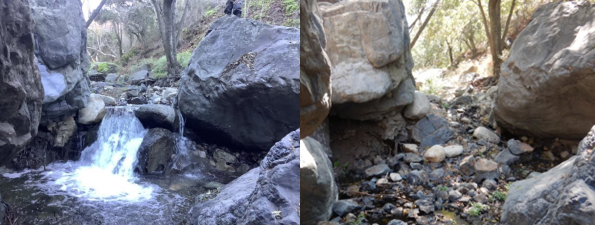 Figure 4. A photo from January 2022 (left) showing the previous fish barrier, and one from the July 2022 snorkel survey (right) showing the remnants. O. mykiss were able to make it up and over this recently demolished barrier to populate upper portions of Trabuco.
Figure 4. A photo from January 2022 (left) showing the previous fish barrier, and one from the July 2022 snorkel survey (right) showing the remnants. O. mykiss were able to make it up and over this recently demolished barrier to populate upper portions of Trabuco.
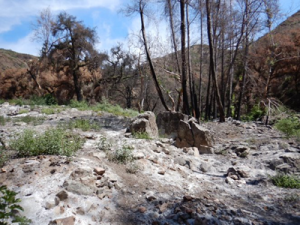 Figure 5. A recovering burn scar in Holy Jim Canyon five months after the Jim Fire, August 2022.
Figure 5. A recovering burn scar in Holy Jim Canyon five months after the Jim Fire, August 2022.
In March of 2022, a fire was ignited during a barrier removal in Holy Jim Canyon, burning almost 500 acres of forest (Figure 5). Holy Jim was visited five months later to assess post-fire conditions. No fish species were observed in the stream, although there were sections of the stream that had overgrowth of aquatic vegetation and woody debris. The stream had a noticeable layer of silt. New vegetative growth in the burn scar reassured that this portion of the canyon is beginning to recover.
Future Efforts
CDFW staff will continue to monitor Trabuco and Holy Jim Creek stream conditions and conduct yearly assessments on O. mykiss and Arroyo Chub population abundance. Fish rescues and relocations will be conducted as needed. Staff will also continue to support barrier removals within the San Juan Creek watershed.
Works Cited
Prepared by:
Brian Bales, Scientific Aid, CDFW
Emely Romo, Scientific Aid, CDFW
Shelley Hunter-Shatsnider, Environmental Scientist, CDFW